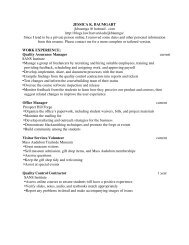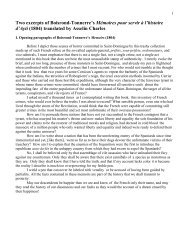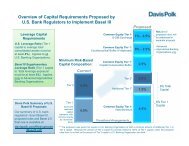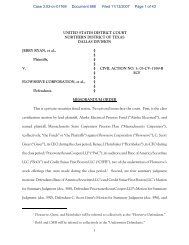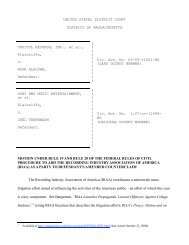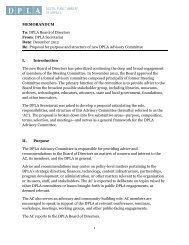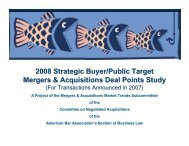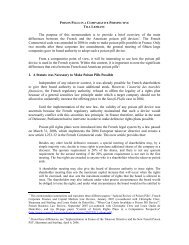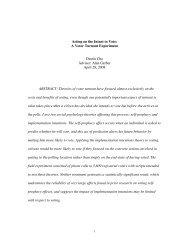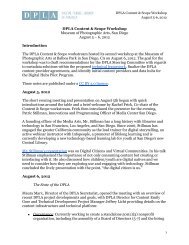Audience and Participation Workshop - Digital Public Library of ...
Audience and Participation Workshop - Digital Public Library of ...
Audience and Participation Workshop - Digital Public Library of ...
Create successful ePaper yourself
Turn your PDF publications into a flip-book with our unique Google optimized e-Paper software.
DPLA <strong>Audience</strong> <strong>and</strong> <strong>Participation</strong> <strong>Workshop</strong><br />
Roy Rosenzweig Center for History <strong>and</strong> New Media<br />
George Mason University, Fairfax, VA<br />
December 6, 2012<br />
1<br />
These notes are published under a CC BY 3.0 license<br />
DPLA <strong>Audience</strong> <strong>and</strong> <strong>Participation</strong> <strong>Workshop</strong><br />
December 6, 2012<br />
The DPLA <strong>Audience</strong> & <strong>Participation</strong> workstream hosted its third workshop at the Roy<br />
Rosenzweig Center for History <strong>and</strong> New Media at George Mason University in Fairfax,<br />
VA on December 6, 2012. The goal for the workshop was to discuss strategies for<br />
institutional participation, contemplate <strong>and</strong> describe the motivations <strong>and</strong> goals <strong>of</strong> 5 – 7<br />
“personas” for the DPLA front-end, <strong>and</strong> to discuss the key elements <strong>of</strong> the DPLA’s<br />
marketing <strong>and</strong> br<strong>and</strong>ing strategy moving forward, keeping in mind the DPLA’s likely<br />
technical architecture <strong>and</strong> content infrastructure.<br />
I. Introduction<br />
Dan Cohen, Director <strong>of</strong> the Roy Rosenzweig Center for History <strong>and</strong> New Media (RRCH),<br />
welcomed guests <strong>and</strong> commenced the workshop at 10 AM EST. He explained that the<br />
RRCH shares a similar set <strong>of</strong> goals <strong>and</strong> guiding principles with the DPLA: a belief in<br />
open access for content <strong>and</strong> open source for code, <strong>and</strong> a commitment to a nonhierarchical<br />
organizational structure.<br />
Michael Colford, Director <strong>of</strong> <strong>Library</strong> Services for the Boston <strong>Public</strong> <strong>Library</strong>, provided<br />
context behind the workshop’s organization <strong>and</strong> purpose. The impetus to convene a<br />
workshop to discuss institutional participation, library outreach, <strong>and</strong> marketing was<br />
based on a conversation that he <strong>and</strong> other <strong>Audience</strong> <strong>and</strong> <strong>Participation</strong> conveners had at<br />
the DPLA Midwest plenary meeting in October 2012 in Chicago.<br />
<strong>Digital</strong> Hubs Pilot Project<br />
Emily Gore, DPLA Director for Content, then provided background on the <strong>Digital</strong> Hubs<br />
Pilot Project for participants unfamiliar with the initiative. Under the Hubs Project, the<br />
DPLA will undertake the first effort to establish a national network out <strong>of</strong> the over forty<br />
state digital projects, numerous large content repositories, <strong>and</strong> other promising<br />
initiatives currently in operation across the United States, bringing together myriad<br />
digitized content from across the country into a single access point for end users. The<br />
approach is to work with seven states or regions (Service Hubs) <strong>and</strong> an equal number <strong>of</strong><br />
content providers (Content Hubs) to aggregate content on a pilot basis.<br />
Gore differentiated between the two types <strong>of</strong> hubs:
2<br />
These notes are published under a CC BY 3.0 license<br />
DPLA <strong>Audience</strong> <strong>and</strong> <strong>Participation</strong> <strong>Workshop</strong><br />
December 6, 2012<br />
1 Service Hubs: State or regional digital libraries that aggregate metadata from<br />
cultural heritage institutions within its given state or region for DPLA harvesting.<br />
Service Hubs also provide a suite <strong>of</strong> services to institutions in its state or region,<br />
including digitization, metadata consultations, community engagement<br />
opportunities, <strong>and</strong> other services.<br />
2 Content Hubs: Large pre-existing repositories <strong>of</strong> digital content, such as Harvard<br />
University <strong>and</strong> the National Archives <strong>and</strong> Records Administration (NARA), that<br />
will share a 1:1 relationship with the DPLA, <strong>of</strong>fering its data directly to the DPLA<br />
for harvesting.<br />
Gore stated that part <strong>of</strong> the goal in building this type <strong>of</strong> tiered infrastructure was to limit<br />
the number <strong>of</strong> 1:1 relationships with content-providing institutions, as it would prove<br />
prohibitively resource-intensive for the DPLA to maintain individual relationships with<br />
every data-providing institution. The DPLA will, for the foreseeable future, have a small<br />
staff.<br />
The common denominator between the various Hubs is the metadata they provide <strong>and</strong><br />
the license associated with it. To participate in the DPLA, Hubs must institute a CC0 1.0<br />
Universal (CC0 1.0) <strong>Public</strong> Domain Dedication for all metadata provided to the DPLA<br />
for harvesting. This approach facilitates the use <strong>and</strong> re-use <strong>of</strong> DPLA data <strong>and</strong> should be<br />
considered in the DPLA’s marketing strategy, participants noted.<br />
II. Institutional/Organizational <strong>Participation</strong> in the DPLA<br />
A main concern for the growth <strong>of</strong> the DPLA’s network <strong>of</strong> content is how the project will<br />
reach out to institutions that don’t have a service hub in their state or region. As there<br />
have been many institutions that have expressed interest in participating, an idea for<br />
increasing the DPLA’s presence is to make a list <strong>of</strong> about 40 statewide organizations <strong>and</strong><br />
coordinate with them, which would in effect increase the ability for individuals to reach<br />
out to their local cultural heritage institutions. Institutions could connect with potential<br />
service hubs in their area.<br />
The role <strong>of</strong> state libraries, including those which distribute LSTA funding, is an<br />
important idea to explore for opportunities for collaboration. Getting state libraries on<br />
board, by way <strong>of</strong> getting the Chief Officers <strong>of</strong> State <strong>Library</strong> Agencies (COSLA) on board,<br />
would strengthen the idea that the DPLA is a national endeavor.
3<br />
These notes are published under a CC BY 3.0 license<br />
DPLA <strong>Audience</strong> <strong>and</strong> <strong>Participation</strong> <strong>Workshop</strong><br />
December 6, 2012<br />
Strategies for defining outreach <strong>and</strong> audience targeting were discussed. Gore described<br />
the QA/QC (quality assurance/quality control) process around the metadata <strong>and</strong><br />
metadata mapping process, stressing the importance <strong>of</strong> setting the expectation that<br />
there is a process for bringing the audience onto the website.<br />
On April 18-19, 2013, the DPLA will <strong>of</strong>ficially launch a prototype front-end in Boston,<br />
MA. April 2013 was discussed as an appropriate time for the DPLA to begin making<br />
statements on how people can get involved in the hub network. It was noted that the<br />
DPLA’s website contains a form for people <strong>and</strong> institutions to commit to the DPLA even<br />
if they do not have the ability to contribute at that time. In April, the DPLA intends to<br />
announce the names <strong>of</strong> those who have committed to contribute in hopes that other<br />
institutions will sign on.<br />
Participants discussed ways in which the DPLA might target specific audiences. To<br />
clarify how best the DPLA can successfully reach its target audience, it is crucial to<br />
define who the DPLA is being marketed to within institutions. For example, is the DPLA<br />
marketing to administrators, coders, or librarians? One participated noted that this set<br />
<strong>of</strong> questions can be h<strong>and</strong>led as a classic sales acquisition strategy.<br />
There are a h<strong>and</strong>ful <strong>of</strong> different paths the DPLA can follow, including collection<br />
development leads, going into local cultural heritage societies (on a more specific level,<br />
connecting with people who have done surveys <strong>of</strong> cultural heritage institutions <strong>and</strong><br />
therefore know their constituencies), <strong>and</strong> going around to state or regional archives that<br />
are looking to gather materials from local historical societies <strong>and</strong> then providing them<br />
with scanning materials. An iteration <strong>of</strong> this idea has been previously brought up in<br />
various DPLA groups as a “Scannebago” project.<br />
III. From Use Cases to Personas<br />
Aaron Schmidt, from Influx, led the personas workshop. He began by defining personas<br />
as fictional users <strong>of</strong> a product or service that are meant to build empathy around<br />
site/service uses <strong>and</strong> needs. The goal for this session was to discuss what users might do<br />
on the DPLA website, or, in other words, user behavior as opposed to strict feature<br />
interaction.<br />
There already exists use cases <strong>and</strong> API use cases, but the priority at this point in time,<br />
pre-April 2013 launch, is to develop personas for the DPLA to provide to iFactory to<br />
further develop the front-end website. The DPLA is different from other libraries
4<br />
These notes are published under a CC BY 3.0 license<br />
DPLA <strong>Audience</strong> <strong>and</strong> <strong>Participation</strong> <strong>Workshop</strong><br />
December 6, 2012<br />
because it provides a spectrum <strong>of</strong> hidden, invisible <strong>and</strong> distributed content without cost<br />
to the user, providing a one-stop shop for digitized materials across the US.<br />
Skeletons <strong>of</strong> personas<br />
• Students<br />
• Home schooled students<br />
• <strong>Public</strong> school students<br />
• Teachers<br />
• Scholars<br />
• Other institutions (people contributing)<br />
• Local cultural heritage groups<br />
• Museums<br />
• Historical societies<br />
• Libraries<br />
• <strong>Public</strong> Libraries<br />
• Librarians<br />
• Casual searchers<br />
• Hardcore enthusiasts<br />
• Wikipedia/OS folks<br />
• Small business/start ups<br />
• Genealogy people (in <strong>of</strong>ten cases #1 users)<br />
• The press<br />
• Writers, artists<br />
The next step for participants was to brainstorm what users might want to do on the<br />
DPLA site, not necessarily functions that the DPLA would be able to provide. These user<br />
behaviors were organized according to the skeleton personas listed above. The<br />
participants had a chance to put their own ideas up on the board, but most <strong>of</strong> these ideas<br />
were slimmed down for the final 5-7 personas.<br />
For a complete listing <strong>of</strong> the behaviors developed during the personas session, see<br />
<strong>Audience</strong> <strong>and</strong> <strong>Participation</strong> user behavior brainstorming.<br />
The key component <strong>of</strong> the DPLA, as determined by the participants, is to provide users<br />
with the ability to be a part <strong>of</strong> something that is bigger than oneself, stressing a social<br />
connectivity component. One participant said that this lends credence to the fact that<br />
digital technology does not replace people <strong>and</strong> that libraries have always existed as<br />
intermediaries/facilitators.
IV. From Use Cases to Personas to Use (continued)<br />
5<br />
These notes are published under a CC BY 3.0 license<br />
DPLA <strong>Audience</strong> <strong>and</strong> <strong>Participation</strong> <strong>Workshop</strong><br />
December 6, 2012<br />
The group took a brief break then reconvened to collocate the various behaviors into<br />
similar behaviors <strong>and</strong> groups.<br />
Determined behavior groups<br />
• Finding specific knowledge: User has specific goals such as “I need to<br />
find this,” or “I’m working on this <strong>and</strong> I need to find this type <strong>of</strong> work.” This can<br />
include looking for local/personal history, non-local items, or open-ended<br />
searches.<br />
• Harvest <strong>and</strong> reuse: The user is looking to create a visualization, or<br />
they’re pulling together a collection <strong>of</strong> things. This behavior can also be<br />
associated with the use <strong>of</strong> developer tool kits.<br />
• Learn: This includes the broad behavior <strong>of</strong> acquisition <strong>of</strong> skills <strong>and</strong>/or<br />
general exploration.<br />
• Contribution: The user is looking to add to a hub <strong>of</strong> some sort, or to<br />
enhance records that already exist by way <strong>of</strong> reviews, corrections, augmentations,<br />
<strong>and</strong> so forth.<br />
• Sharing/Connecting: A people-focused behavior that treats the DPLA<br />
as a tool to exp<strong>and</strong> their own network <strong>of</strong> people, to find partners, to start a book<br />
group, <strong>and</strong> so forth.<br />
• Generic: A user looks to have an increased access to information, wants<br />
to inspire people, <strong>and</strong>/or make something more accessible to a larger audience.<br />
Schmidt concluded the session with a debrief <strong>of</strong> the collocation <strong>and</strong> sub-grouping<br />
process. On a final note, one participant noted that the session did not thoroughly<br />
discuss the creation component, stressing that behavior could be a part <strong>of</strong> contribution,<br />
or the reuse <strong>and</strong> harvesting aspect.<br />
V. Marketing <strong>and</strong> Br<strong>and</strong>ing<br />
Some concepts <strong>of</strong> marketing <strong>and</strong> br<strong>and</strong>ing were touched upon earlier in the<br />
“Institutional/Organizational <strong>Participation</strong> in the DPLA” session, but participants<br />
wanted to go more in depth on the topic <strong>of</strong> DPLA br<strong>and</strong>ing in the context <strong>of</strong> both the<br />
front-end website <strong>and</strong> integration with local library websites.<br />
From a br<strong>and</strong>ing perspective, the DPLA wants to come <strong>of</strong>f as a complementary endeavor<br />
that supports tech infrastructure. Participants talked about searching collections from<br />
the DPLA front-end. Once the user has been directed <strong>of</strong>f the DPLA website, are they able
6<br />
These notes are published under a CC BY 3.0 license<br />
DPLA <strong>Audience</strong> <strong>and</strong> <strong>Participation</strong> <strong>Workshop</strong><br />
December 6, 2012<br />
to make the next leap into their research or will they need to redirect elsewhere? With<br />
the Integrated <strong>Library</strong> System vendors, one idea would be to bring the DPLA API to<br />
them <strong>and</strong> have them build it into their <strong>of</strong>ferings. A participant brought up the idea <strong>of</strong> the<br />
DPLA functioning as a next level reference service that asks, “what are you looking for?”<br />
Participants brought up a few concerns including the tension between a central DPLA<br />
website <strong>and</strong> locally installed instances, as well as worries that the recent focus on the<br />
front-end portal might mislead people to think that the DPLA is interested in just<br />
building the front-end portal. This tension is more closely seen between the meta-level<br />
project <strong>and</strong> infrastructure.<br />
There were also a few comments about possible URL changes for the DPLA. One<br />
possible domain is “library.us,” which is currently owned by the Department <strong>of</strong><br />
Commerce.<br />
Returning to a discussion <strong>of</strong> marketing, participants noted that the main product being<br />
brought to market, in their estimation, is a display <strong>of</strong> the DPLA’s power as a resource<br />
portal, meaning a one stop shop for a large breadth <strong>of</strong> content, from big institutions’<br />
archives to rural area artifacts.<br />
Marketing to developers<br />
Participants discussed the importance <strong>of</strong> targeting developers <strong>and</strong> the development<br />
community during this period in the DPLA’s evolution, when the technical<br />
infrastructure is being put into place <strong>and</strong> the platform is young. Some participants noted<br />
that the development community is ideally going to build out the DPLA’s technical<br />
<strong>of</strong>fering, which would in turn allow for a more substantial product to be brought to a<br />
marketing firm at a later date, if needed. To target this group, it was suggested that the<br />
documentation around the API be spotlighted to show how the DPLA is being made, as<br />
well as providing a clear means to foster communication (i.e., have a go-to person within<br />
the community to answer questions). Another arm <strong>of</strong> the strategy is to build more<br />
community through face-to-face meetings, IRC, mailing lists, <strong>and</strong> a thriving hub on<br />
Github for code to be shared. The DPLA wants to make it as easy as possible for<br />
developers to get involved.<br />
The pitch for developers would be multi-faceted, focusing mostly on pre-established<br />
communities <strong>and</strong> events in order to create a focus on how huge the potential for<br />
community engagement is already. The group project contest at Appfest in November<br />
2012 in Chattanooga was a great example <strong>of</strong> a face-to-face hackfest get-together. Ideas
7<br />
These notes are published under a CC BY 3.0 license<br />
DPLA <strong>Audience</strong> <strong>and</strong> <strong>Participation</strong> <strong>Workshop</strong><br />
December 6, 2012<br />
could also be seeded into Computer Science programs in graduate schools/colleges<br />
across the country, <strong>and</strong> in high schools with strong computer science programs.<br />
There is the potential for the creation <strong>of</strong> an interest group in LITA (part <strong>of</strong> the ALA)<br />
which would provide the opportunity to gain space at ALA meetings for hackathons.<br />
One participant stepped up to spearhead the formation <strong>of</strong> such a group.<br />
The promotion <strong>of</strong> liberated data was believed to be a huge selling point to developers. By<br />
showing them that the DPLA has an open API that provides access to millions <strong>of</strong> data<br />
sets, many developers will become interested.<br />
One participant chimed in by saying that JSON-LD, the language in which data is<br />
returned to a user who queries the API, is a bit complicated for most ordinary hackers<br />
<strong>and</strong> that they’re used to simple arrays, creating a possible hurdle for some developers. In<br />
an attempt to assuage the possible problem, examples could start with a simplified<br />
version, a mini-version with a small subsection, for example, so that they could add to a<br />
simple application. By building a series <strong>of</strong> modules, or a sort <strong>of</strong> stepping stone, people<br />
would have an easier time getting used to the complexity. The type <strong>of</strong> developers <strong>and</strong><br />
casual hackers that are attracted to the full suite <strong>of</strong> JSON-LD are semantic web, linked<br />
data type people.<br />
A key marketing piece is the complexity <strong>and</strong> richness <strong>of</strong> this approach. While a lot <strong>of</strong> the<br />
more upper-level, complex factors can be stripped out, there is a huge potential<br />
applications employing the linked data component <strong>of</strong> JSON-LD. Participants noted that<br />
this is unique to the DPLA <strong>and</strong> should be integrated into marketing to developers.<br />
Individual <strong>and</strong> institutional motivation<br />
The motivations for individuals <strong>and</strong> institutions to get involved with the DPLA are<br />
numerous. Many open source developers are interested in simply making things. There<br />
are also many organizations that are eager to contribute content to the site. One<br />
participant personally mentioned that they were a fan <strong>of</strong> digital challenges or<br />
competitions, <strong>and</strong> in the past they have been motivated by monetary reward or the<br />
opportunity for travel.<br />
A game plan for near-future marketing efforts was developed. One participant is<br />
convening “Libraries as the Ultimate Playground” at SXSW. Another idea was to do an<br />
asynchronous competition for the launch. Perhaps, there could be a pilot program<br />
wherein schools use the DPLA dataset <strong>and</strong> API to compete against one another.
8<br />
These notes are published under a CC BY 3.0 license<br />
DPLA <strong>Audience</strong> <strong>and</strong> <strong>Participation</strong> <strong>Workshop</strong><br />
December 6, 2012<br />
One participant aired caution towards the focus <strong>of</strong> the DPLA catering its marketing<br />
efforts towards advanced developers. There needs to be something that has low barrier<br />
entrance activities so that people with relatively limited experience can still<br />
meaningfully participate, they pointed out.<br />
Marketing to libraries<br />
In order for the DPLA to serve as a useful resource, it is crucial for libraries to<br />
underst<strong>and</strong> the purpose <strong>and</strong> function <strong>of</strong> the DPLA so as to erase confusion <strong>and</strong> dispel<br />
misconceptions. One participant stressed the need to have a grassroots effort to conduct<br />
conversations with school librarians about the DPLA. One example, they pointed out,<br />
would be to have more school librarians <strong>and</strong> teachers at DPLA gatherings.<br />
VI. Key Takeaways<br />
Marketing to developers<br />
Participants readily agreed that a significant component <strong>of</strong> the DPLA’s success will lie in<br />
its ability to reach out to <strong>and</strong> engage with the development community. The group<br />
recommended that the DPLA develop a marketing strategy directed toward developers<br />
that succinctly describes the API <strong>and</strong> uses, ideally highlighting the possibilities <strong>and</strong><br />
power <strong>of</strong> JSON-LD <strong>and</strong> other features <strong>of</strong> the API. The group also recommended<br />
instituting a means <strong>of</strong> communication based around technical development <strong>of</strong> the<br />
DPLA, such as a moderated forum or listserv moderated by a go-to DPLA staff person.<br />
Hackathons <strong>and</strong> other events<br />
The group discussed <strong>and</strong> recommended the development <strong>of</strong> both informal <strong>and</strong> formal<br />
hackathons based around the DPLA API <strong>and</strong> platform, modeled in part on the success <strong>of</strong><br />
the November 2012 Appfest hackathon at the Chattanooga (TN) <strong>Public</strong> <strong>Library</strong>.<br />
Marketing to libraries <strong>and</strong> end-users<br />
As the project approaches <strong>and</strong> surpasses the April 2013 launch, the DPLA’s marketing<br />
strategy should pivot in part from a more technical focus based on metadata <strong>and</strong><br />
aggregation to one that’s directed towards end-users, whether individuals, librarians, or<br />
institutions. Marketing to graduate <strong>and</strong> undergraduate schools was also recommended,<br />
using computer science programs as a good place to seek ideas <strong>and</strong> seed direct<br />
contribution.



